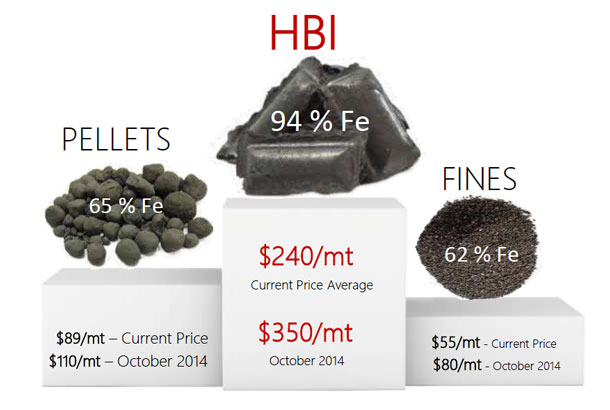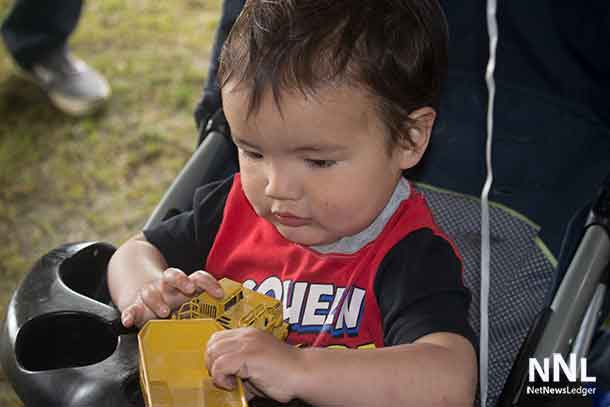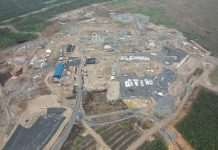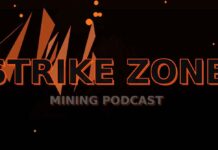

THUNDER BAY – MINING – Rockex Mining Corporation (“Rockex” or the “Corporation”) (CSE: RXM) is pleased to announce the results of an updated Preliminary Economic Assessment (“PEA”) on the Corporation’s 100% owned Lake St. Joseph Project (“Lake St. Joseph”) in Northwestern Ontario. The PEA was prepared by CIMA+ (“CIMA”) for the production of 4.3 million tonnes per year of hot briquetted iron (“HBI”). The PEA will be filed on SEDAR and Rockex’ website within 45 days of this news release.
Highlights of the PEA Include:
- $ 9.42 Billion Net Present Value (pre-tax) using a 6% discount rate
- $ 6.85 Billion Net Present Value (post-tax) using a 6% discount rate
- $ 6.58 Billion Net Present Value (pre-tax) using an 8% discount rate
- $ 4.67 Billion Net Present Value (post-tax) using an 8% discount rate
- 5% Internal Rate of Return (pre-tax)
- 5% Internal Rate of Return (post-tax)
- 7 year undiscounted payback (pre-tax)
- 1 year undiscounted payback (post-tax)
- Initial Investment of $3.772 billion (not including sustaining capital)
- Total cost of production estimated at $135.35/tonne of HBI
- Resource Estimate of an Indicated Mineral Resource of 1.287 billion tonnes at 28.39% Fe, plus an Inferred Mineral Resource of 108 million tonnes at 31.03%
- Life of Mine Production of 4.3 million tonnes of HBI per year for 30 years, with an expected metallization of 94% Fe.
- Low strip ratio of 0.51 to 1
* Unless otherwise expressly stated all references to currency, are references to Canadian currency. The PEA uses a currency exchange rate of US$0.85 = Cdn$1.00.
“We are very pleased with the results of the updated PEA. The release of this economic report is a major milestone for Rockex and marks the culmination of many years of work by our team. This PEA presents Lake St. Joseph’s strong economic potential and confirms management’s belief in the quality of the deposit and overall project. Furthermore, this PEA is a critical valuation and marketing document that will give Rockex excellent positioning for hosting the first HBI plant in Canada, which we are confident will attract negotiations with a strategic partner,” said Armando Plastino, Rockex’ Chief Executive Officer.
Summary
The PEA is based on the production of 4.3 million tonnes of HBI per year at a grade of 94% total iron (“Fe”) at the Rockex Lake St. Joseph Project in northwestern Ontario. The average run of mine feed of 17.3 million tonnes per year used is based on mill recovery of 80% from the Eagle Island deposit operating year-round. The life of mine of 30 years is based on 512 million tonnes of in-pit resources at a grade of 28.9% Fe which uses less than half of Eagle Island’s estimated Indicated Resources of 1.287 billion tonnes at a grade of 28.39% Fe, allowing the opportunity for continuing production for many years following the 30-year life of mine used for the PEA. The PEA contemplates a process whereby iron ore concentrate will be transferred by pipeline to a pelletizing plant and HBI plant to be built near Sioux Lookout, Ontario. The plant is expected to produce 4.3 million tonnes per year of HBI. Initial capital expenditures are estimated to be $3.772 billion. The PEA uses an average operating cost of $135.35 per tonne of HBI, and assumes an HBI sales price of US$ 350 per tonne FOB Sioux Lookout. Calculated Net Present Value for the Lake St. Joseph Project is
$9.42 billion (pre-tax) using a 6% discount rate and $6.58 billion (pre-tax) using an 8% discount rate. The PEA is based on the 2013 independent mineral resource estimate completed by Met-Chem Canada Inc. (“Met-Chem”) which defined 1.287 billion tonnes of Indicated Resources at a grade of 28.39% Fe and 108 million tonnes of Inferred Resources at a grade of 31.03% Fe. The resource is summarized in Table 1 below.
Table 1: Summary of Mineral Resource Estimate (2013)
| Mineral Resource Category | Metric Tonnes (Billion) | Fe (%) |
| Indicated | 1.287 | 28.39 |
| Inferred | 108 | 31.03 |
The updated PEA (2015) is based on the same basic mining method and processing flow sheet utilized in the original (2013) PEA; however, the updated PEA evaluates the economic impact of further processing the mine’s production to HBI as an end product in place of pellet feed concentrate. As illustrated in Table 2 below, the updated PEA (2015) further improves the project economics relative to the previous study.
Table 2: Comparison of the Original (2013) and Updated (2015) PEA
| Category | PEA 2013 (Fines) | PEA 2015 (HBI) | |
| Production Rate | |||
| Pellet Feed Concentrate (Mtpa) | 6.0 | 6.0 | |
| Pellet (Mtpa) | – | 6.1 | |
| HBI (Mtpa) | – | 4.3 | |
| Projected Mine Life (yrs) | 30 | 30 | |
| Commodity Price Assumption | |||
| Pellet feed, FOB Sioux-Lookout ($US/t) | 105 | – | |
| HBI, FOB Sioux-Lookout ($US/t) | – | 350 | |
| LOM Revenue (M$) | 19,812 | 52,683 | |
| Initial Capital (M$) | 1,559 | 3,772 | |
| Working Capital (M$) | 48.1 | 129.6 | |
| Sustaining Capital (M$) | 543 | 538 | |
| Closure Cost (M$) | 65.7 | 65.7 | |
| Average Operating Costs | $/t of pellet feed | $/t of pellet feed | $/t of HBI |
| Mining cost | 12.76 | 12.76 | 17.88 |
| Concentrator & tailings cost | 18.05 | 18.05 | 25.29 |
| Concentrate dewatering cost | 1.83 | – | – |
| Railroad | 0.20 | 0.20 | 0.28 |
| General & administration cost | 3.79 | 4.52 | 6.33 |
| Pelletizing cost | – | – | 19.13 |
| Briquetting cost | – | – | 66.44 |
| Total Operating Cost ($/tonne) | $36.63 | – | $135.35 |
| Manpower Requirements | |||
| Mine | 180 | 180 |
| Concentrating & Tailings | 114 | 114 |
| Concentrate dewatering | 36 | – |
| General & administration | 49 | 89 |
| Rail | 6 | 6 |
| Pelletizing | – | 127 |
| Briquetting | – | 200 |
| Total Manpower | 385 | 716 |
| Pre-Tax Economic Indicators | ||
| NPV @ 8% | 2,217 | 6,577.5 |
| IRR (%) | 20.7 | 22.5 |
| Payback (yrs) | 4.2 | 3.7 |
| Post-Tax Economic Indicators | ||
| NPV @ 8% | 1,553.7 | 4,672.6 |
| IRR (%) | 18.1 | 19.5 |
| Payback (yrs) | 4.4 | 4.1 |
HBI
The updated PEA (2015) is based on the transformation of iron ore concentrate into HBI as an end product to supply the North American electric arc furnace industry and grey foundry industry. HBI is considered to be a cleaner, higher quality, finished iron product for the steel industry. HBI is an ideal, high quality alternative to scrap steel, which is a vital component in the steel manufacturing process. The HBI process requires access to an abundant and low cost source of natural gas. Rockex’ proximity to the TransCanada Natural Gas Pipeline and year-round transportation infrastructure positions the company well for the manufacturing of HBI to supply the North American market in the United States immediately south of the Great Lakes and in Canada.
Mining
In 2013, Met-Chem evaluated the potential for an open pit mine at Lake St. Joseph to produce 6 million tonnes of iron concentrate per year at a grade of 66.3% Fe. The mining method selected for the project was a conventional open pit ‘drill and blast’ operation with rigid frame haul trucks (218 tonne payload) and hydraulic shovels. The pit design and mine plan were limited to a 30-year mine life, although the pit optimization showed sufficient resources for a longer period. The designed pit included 512 million tonnes of mineral resources with an average grade of 28.9% Fe and a stripping ratio of 0.51:1. An average run of mine feed of 17.3 million tonnes per year (47,500 tpd) is required, assuming a mill recovery of 80%, to produce 6 million tonnes of concentrate per year at a grade of 66.3% Fe.
Concentrating
The concentrator will be located adjacent to the Eagle Island causeway on the south shore of Lake St. Joseph. Mined mineralized material will be crushed using a gyratory crusher before being conveyed to the processing plant. Concentrate will be thickened to 65% solids prior to pumping to the pelletizing facility located near Sioux Lookout. Tailings are also thickened before being pumped to the tailings pond. Final concentrate will grade 66.3% Fe and 5.23% SiO2.
Pellet Plant
The pellet plant, to be located near Sioux Lookout, will receive concentrate slurry from the pipeline, de- water it and combine it with bentonite/limestone ground to pelletizing fineness. The mixed material will be balled and then hardened by heating to 1,270°C using natural gas, followed by cooling and transporting to the pellet stockyard.
HBI Plant
Using gas-based direct reduction processes, the HBI plant will have a capacity of producing 4.3 million tonnes of HBI per year. The hot briquetting is undertaken in a shaft-based furnace, where the pellets are introduced through a proportioning hopper at the top of the shaft furnace. As the pellet descends through the furnace by gravity flow, it is heated and the oxygen is removed by counter-flowing gases (hydrogen and carbon monoxide). The hot feed is pushed by a screw into the nip between two counter-rotating rollers. Pockets in the rollers form the briquettes at high temperatures (700°C) under high pressure. The continuous string of briquettes is broken into mostly single briquettes as they are cooled. The briquettes are expected to contain 90-94% total iron (Fe) in a nearly pure form.
HBI Sales Price
Based on a survey of recent studies, the selling price of the HBI was established at US$ 350 FOB Sioux Lookout for the Lake St. Joseph Project. Sioux Lookout is connected by major rail lines to the industrial heartland of the United States where significant steel-making and grey foundry industries are located, as well as to ports on the Great Lakes and the West Coast for shipping HBI to North American, European and Chinese markets.
Operating Cost Summary
The PEA operating costs were estimated based on economic assumptions and estimates of consumable prices from suppliers. Table 3 outlines the estimated operating costs for a typical operating year as:
Table 3: Estimated operating costs for a typical operating year
| Operating Costs | $/tonne HBI |
| Mining | 17.88 |
| Concentrating and tailings | 25.29 |
| General and administration | 6.33 |
| Rails | 0.28 |
| Pelletizing | 19.13 |
| Briquetting | 66.44 |
| Total | $135.35 |
Mineral Resource Calculation
An updated independent mineral resource estimate by Met-Chem in 2013 defined 1.287 billion tonnes of Indicated Resources at a grade of 28.39% Fe, and 108 million tonnes of Inferred Resources at a grade of 31.03% Fe. The resources estimate includes the Main Zone and South-east Zone deposits on Eagle Island only and forms the basis for the PEA.
Pre-Feasibility and Opportunities
Management believes ongoing test work and feasibility trade-off studies will further improve the overall capital and operating costs of the project. Rockex recently entered into a Co-operation Agreement with Danieli & C., a large multi-national engineering and technology firm with expertise in the design and construction of HBI plants. Rockex’ management team, in collaboration with Danieli & C., will continue to market and promote the project to potential strategic partners, financiers and final product off-takers that can support Rockex’ plans for the preparation of a bankable feasibility study.
Qualified Persons
The PEA was prepared under the supervision of Jean-Sébastien Tremblay, Eng. of CIMA. Mr. Tremblay is a Qualified Person as defined by NI 43-101.
Met-Chem’s Yves A. Buro, Eng., and Schadrac Ibrango, P.Geo., Ph.D., are responsible for validating the geological interpretation and the database and for the mineral resources estimate.
Georgi Doundarov, P.Eng., is responsible for supervising the mineral processing and metallurgical test work and the recovery methods.
Met-Chem’s Jeffrey Cassoff, Eng., is responsible for supervising the mining. Michel L. Bilodeau, Eng., is responsible for the economic analysis.
All of the Qualified Persons cited above are independent of Rockex within the meaning of NI 43-101, Standards of Disclosure for Mineral Projects, of the Canadian Securities Administrators and have reviewed and approved the contents of this news release.
About CIMA+
CIMA is an internationally renowned consulting engineering firm established to provide all phases of geology, mining, mineral processing and engineering services throughout the world. From its headquarters in Montreal, CIMA offers the mining industry professional expertise that covers scoping, pre-feasibility and feasibility studies, basic and detailed engineering, procurement and construction management, training, start-up, commissioning and operations assistance.
About Rockex
Rockex is a Canadian exploration company focused on developing high quality iron ore assets strategically located in areas largely under explored, and that host significant mineral potential. Its core asset the Lake St. Joseph Project which includes the Eagle Island Deposit, as well as additional potential deposits at Wolf Island and Fish Island. Rockex holds a 100% interest in its Lake St. Joseph project which is comprised of 13 contiguous mining claims that cover a vast geographic area of approximately 2,592 hectares, located approximately 100 kilometres northeast of Sioux Lookout and 80 kilometres south-southwest of Pickle Lake in northwestern Ontario.
Rockex also holds a 100% interest in two other iron projects in relative close proximity to Eagle Island deposit: (i) East Soules Bay, a property consisting of 4 contiguous mining claims and 1 non-contiguous mining claim, in and along the eastern end of Lake St. Joseph, approximately 40 kilometres east of Rockex’ Eagle Island Iron Project, and (ii) the Root Lake Project, a property consisting of 5 contiguous claims.
In addition, Rockex holds a 100% interest in a fifth iron project in Northwestern Ontario, the North Spirit Lake Property in the Buckett Lake and Hewett Lake Townships, Red Lake Mining Division, District of Kenora, consisting of eight contiguous mining claims, approximately 170 km northeast of Red Lake, Ontario.
Please visit the Corporation’s website at www.rockexmining.com






